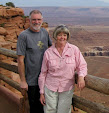
In Prince Rupert the weather continued sunny. We were only staying one day here so did the “whirlwind tour”. Unfortunately the Railway Museum was closed for lunch so we went off for our own lunch in a small but very good restaurant, visited the excellent museum and then drove to Port Edward to visit the old salmon cannery. We arrived just a bit late for the tour but hadn't missed too much so joined in for the remainder.

Many of the old buildings are still standing and many have been fully restored.There was a company store where the company would offer credit to the cannery employees, thus ensuring they wouldn't leave--they always seemed to owe more than their pay brought in.
Next day we headed east on Highway 16 traveling to the Hazeltons where the Bulkley river flows into the Skeena. There are three towns here: Hazelton, often called Old Hazeton to differentiate it from New Hazelton a few kilometres away, and then there is South Hazelton which we didn't visit. Our campground was in the original Hazelton where we spent most of our time.


That evening we were able to use our Starchoice satellite system to view the TV news from home. (Note added later: this would be the last time for a while we would be able to get a shot at the satellite because of trees or mountains!)
In the morning we packed up and backtracked about 40 minutes to the junction of Highway 37, our route north to meet the Alaska Highway. We fueled here then began the run up the 37, almost immediately missing the turn to Gitwangak, a small village with the largest collection of totempoles still in their original location. There was no place to turn around on the highway so we carried on. A little further on we turned off the highway onto the Kitwanga North Road to see an Historical site, Battle Hill. This once fortified village was occupied during the late 1700's and early 1800's. It has close historic ties to Gitwangak, the history being depicted on those totem poles.

A little farther up the highway was the turnoff to the village of Gitanyow, another village with a large number of old totem poles so we stopped once again for a look and more photos. Some homes even had their own individual totem pole.

We made one more stop about this time, 45 minutes at a rest area for lunch. Here while walking the dogs Gillian noticed a duck struggling near the far bank of the fast flowing river, its head barely above water and frequently falling below the turbulent surface. We suspect that its foot was caught in some obstruction. It was very fatigued and would not last long. Unfortunately, being on the wrong side of the river there was nothing we could do. Very sad.
Some 150 kilometers later we reached Meziadin Junction and turned west on 37A to Stewart, BC and Hyder, Alaska. It was a picturesque drive and along the way we stopped for a closer look at the first glacier. At a very reasonable 4:30 PM we pulled into the Bear River RV park just at the outskirts of Stewart. We booked in for 2 nights and got settled in. Art tried the Starchoice satellite but the mountains were in the way. Oh well, the campground was equipped with cable so we were able to see the Vancouver news at least.




















No comments:
Post a Comment